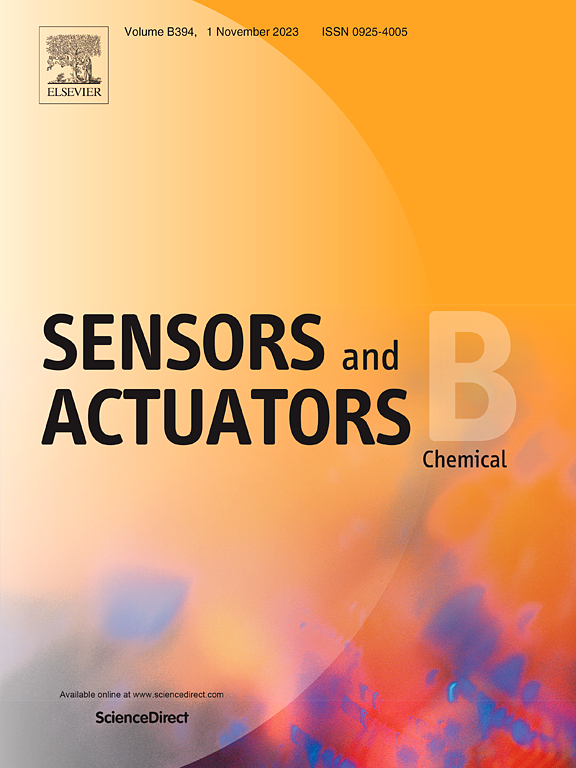胰凝乳蛋白酶成像的高特异性近红外荧光探针:胰腺疾病的创新诊断工具
IF 8
1区 化学
Q1 CHEMISTRY, ANALYTICAL
引用次数: 0
摘要
胰腺疾病与包括胰凝乳蛋白酶在内的多种蛋白酶活性异常密切相关。目前,专门设计用于检测胰腺疾病中凝乳胰蛋白酶的探针尚不可用。在这项研究中,我们开发了一种高度特异性和敏感性的荧光探针来检测胰凝乳蛋白酶活性,从而实现胰腺疾病的精确诊断。该探针以尼罗红作为荧光基团,4-溴丁醇作为识别和猝灭基团,以促进酶切时的“荧光开关”反应。该探针对凝乳胰蛋白酶具有高特异性和敏感性,在48种生物干扰物存在下不受影响。线性检测范围为0.1 ~ 0.75 μg/mL,检出限为0.0203 μg/mL,具有良好的分析性能。细胞实验表明,探针能有效区分正常胰腺细胞和肿瘤细胞。此外,探针在胰腺炎模型中的应用表明,它能够准确区分正常组织、慢性胰腺炎和急性胰腺炎,并为实时成像和疾病进展监测提供强有力的支持。随后的体内实验进一步验证了探针的诊断功效,突出了其在胰腺疾病诊断中的潜力。这些发现为开发用于胰腺疾病早期诊断和治疗监测的分子工具提供了坚实的基础,显示了其在临床诊断和精准医学方面的巨大潜力。本文章由计算机程序翻译,如有差异,请以英文原文为准。

High-specificity near-infrared fluorescent probe for chymotrypsin imaging: Innovative diagnostic tool for pancreatic diseases
Pancreatic diseases are closely linked with the abnormal activity of various proteases, including chymotrypsin. Currently, probes specifically designed for the detection of chymotrypsin in pancreatic disorders are unavailable. In this study, we developed a highly specific and sensitive fluorescent probe for the detection of chymotrypsin activity to enable precise diagnosis of pancreatic diseases. The probe was incorporated with Nile red as the fluorescent moiety and 4-bromobutanoyl as the recognition and quenching group to facilitate a "fluorescence switch" response upon enzymatic cleavage. The probe had high specificity and sensitivity to chymotrypsin, which remained unaffected in the presence of 52 biological interferents. It had a linear detection range of 0.1–0.75 μg/mL and a limit of detection of 0.0203 μg/mL, indicative of superior analytical performance. Cellular assays showed that the probe could effectively distinguish between normal pancreatic cells and tumor cells. Furthermore, the applications of the probe in pancreatitis models revealed its capability to accurately differentiate between normal tissue, chronic pancreatitis, and acute pancreatitis and to provide robust support for real-time imaging and disease progression monitoring. Subsequent in vivo experiments further validated the probe's diagnostic efficacy, highlighting its potential in the diagnosis of pancreatic diseases. These findings provide a solid foundation for developing molecular tools for early diagnosis and therapeutic monitoring of pancreatic disorders, demonstrating its significant potential in clinical diagnostics and precision medicine.
求助全文
通过发布文献求助,成功后即可免费获取论文全文。
去求助
来源期刊

Sensors and Actuators B: Chemical
工程技术-电化学
CiteScore
14.60
自引率
11.90%
发文量
1776
审稿时长
3.2 months
期刊介绍:
Sensors & Actuators, B: Chemical is an international journal focused on the research and development of chemical transducers. It covers chemical sensors and biosensors, chemical actuators, and analytical microsystems. The journal is interdisciplinary, aiming to publish original works showcasing substantial advancements beyond the current state of the art in these fields, with practical applicability to solving meaningful analytical problems. Review articles are accepted by invitation from an Editor of the journal.
 求助内容:
求助内容: 应助结果提醒方式:
应助结果提醒方式:


